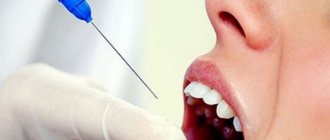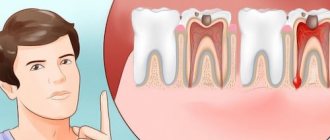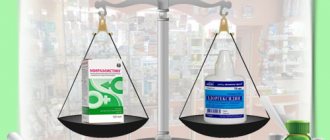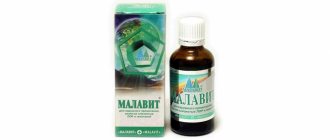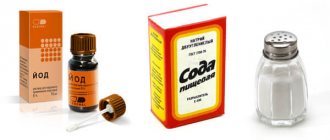Compound
The solution for intravenous administration includes the active component lidocaine hydrochloride (monohydrate form).
An additional component is water for injection. The active component included in the injection solution is also lidocaine hydrochloride (monohydrate form), additional components are sodium chloride, water.
Spray 10% for topical use contains lidocaine , as well as additional components: propylene glycol, peppermint oil, 96% ethanol.
Eye drops contain lidocaine hydrochloride , as well as benzethonium chloride, sodium chloride, and water.
The gel for external use also contains a similar active substance.
Lidocaine release form
The product is available in different forms:
- The solution, which is administered intravenously, is colorless and odorless. The solution is poured into ampoules of 2 ml, 5 pcs. in blister strip packaging. Two such packages are placed in a cardboard pack.
- The solution intended for injection is odorless and colorless, it is bottled in ampoules of 2 ml, in blister packs - 5 such ampoules. A solution of 10%, 2%, 1% is available.
- Spray with lidocaine 10 percent is a colorless alcohol solution that has a menthol aroma. Contained in bottles (650 doses), it is equipped with a special pump and spray nozzle. The bottle is placed in a cardboard box.
- Eye drops 2% are colorless and odorless, but sometimes they may be slightly colored. Contained in 5 ml polyethylene bottles.
- A gel is also available.
pharmachologic effect
Lidocaine - what is it?
Wikipedia indicates that lidocaine is a derivative of acetanilide in chemical structure. It has a pronounced antiarrhythmic and local anesthetic effect.
The pharmacological group to which the active substance belongs is local anesthetics .
Inhibits nerve conduction by blocking sodium channels in nerve fibers and nerve endings, thereby providing a local anesthetic effect.
If we compare the anesthetic effect of procaine , then lidocaine is 2-6 times superior to it. Also, its effects develop faster and last longer. How long the drug lasts depends on the interaction with other drugs. If the drug is used simultaneously with Epinephrine , then the effect lasts more than 2 hours. When applied topically, vasodilation is observed, but no local irritating effect is noted.
In the body, it stabilizes the cell membrane, blocks sodium channels, increases the level of membrane permeability for potassium ions, which determines its antiarrhythmic effect .
Under its influence, repolarization in the ventricles is accelerated, the fourth phase of depolarization in Purkinje fibers is inhibited, without affecting the electrophysiological state of the atria.
It does not have a significant effect on myocardial contractility and conductivity. The negative inotropic effect is slightly pronounced, it manifests itself for a short time and only if the drug is administered in large doses.
Lidocaine solution for injection 20 mg/ml 2 ml amp 10 pcs Grotex
Pharmacological group:
Local anesthetic agent.
Pharmacodynamics:
It has a local anesthetic effect, blocks voltage-dependent sodium channels, which prevents the generation of impulses in the endings of sensory nerves and the conduction of impulses in the endings of sensory nerves and the conduction of impulses along nerve fibers. Suppresses the conduction of not only pain impulses, but also impulses of other modalities. It is used for all types of local anesthesia: infiltration, conduction and superficial. The anesthetic effect of lidocaine lasts up to 75 minutes, and after adding epinephrine - more than 2 hours. When applied topically, it dilates blood vessels and does not have a locally irritating effect.
It has antiarrhythmic (lb class) properties. Stabilizes cell membranes, blocks sodium channels, increases membrane permeability for potassium ions. Almost without affecting the electrophysiological state of the atria, it accelerates repolarization in the ventricles, inhibits phase IV depolarization in Purkinje fibers (especially ischemic myocardium), reducing their automaticity and the duration of the action potential.
Practically does not affect the conductivity and contractility of the myocardium (conduction inhibition is noted when administered only in large, close to toxic doses) - the duration of the PQ, QT intervals (the duration of the ventricular complex, reflecting the duration of the electrical systole of the ventricles) and the width of the QRS complex (the first phase of the ventricular complex, reflecting the process of ventricular depolarization) on the ECG (electrocardiogram) does not change. The negative inotropic effect is also slightly expressed and appears short-term only with rapid administration of the drug in large doses.
Pharmacokinetics:
When administered parenterally, absorption is complete (the rate of absorption depends on the site of administration and dose). The time to reach maximum concentration (Tmax) with intravenous administration is 3-5 minutes. Bonding with plasma proteins is 50-80%. It is distributed quickly (the half-life of the distribution phase is 6-9 minutes), first enters well-supplied tissues (heart, lungs, liver, spleen), then into adipose and muscle tissue. Penetrates the blood-brain barrier and placental barrier, secreted into breast milk (40% of the concentration in maternal plasma).
Half-life (T1/2) (after intravenous bolus administration) - 1.5-2 hours; in newborns - 3 hours. With long-term infusion of lidocaine 8, the duration of 24-48 hours increases significantly (about 3 hours). If liver function is impaired, T1/2 increases by times or more. With continuous infusion (without administration of an initial saturating dose), a therapeutically effective concentration (2-6 mcg/ml) is achieved after 5-9 hours.
Metabolized in the liver (90-95%) with the participation of microsomal enzymes by dealkylation of the amino group and cleavage of the amide bond with the formation of active metabolites (monoethylglycinxylidine and glycinxylidine) with half-life of 2 hours and 10 hours, respectively. In liver diseases, the metabolic rate decreases and ranges from 50% to 10% of the normal value.
Excreted in bile (part of the dose is reabsorbed in the gastrointestinal tract and kidneys (up to 10% unchanged). In chronic renal failure, accumulation of metabolites is possible. Acidification of urine increases the excretion of lidocaine.
Pharmacokinetics and pharmacodynamics
The highest concentration in the blood after intravenous administration is observed after 5-15 minutes, if the infusion is carried out slowly without a saturating initial dose, the maximum concentration is observed after 5-6 hours, and in people with acute myocardial infarction it can be achieved after a long time - up to 10 hours. Binds to plasma proteins by 50-80%. It is quickly distributed in the body and penetrates the placental and blood-brain barriers.
Metabolism mainly occurs in the liver; microsomal enzymes , resulting in the formation of active metabolites - glycine xylidide and monoethylglycine xylidide . People with liver disease have a slower metabolism. Excretion occurs in bile and urine.
If lidocaine cream or other agents are applied topically, absorption depends on the dose and also on the site where the lidocaine cream or gel is applied. Absorption is affected by the rate of perfusion in the mucosa.
There is good absorption in the respiratory tract, so care must be taken to prevent the administration of the drug in toxic doses.
After injections of lidocaine intramuscularly, almost complete absorption is noted. It is distributed quickly and binds to proteins, depending on the concentration of the active ingredient, by 60-80%.
The half-life depends on the dose administered, it is 1-2 hours.
If an aerosol is used, its effect appears within 1 minute and lasts 1-2 minutes. There is a gradual disappearance of the achieved decrease in sensitivity over 15 minutes.
Lidocaine
For infiltration anesthesia: intradermal, subcutaneous, intramuscular. Apply lidocaine solution 5 mg/ml (maximum dose 400 mg)
For blockade of peripheral nerves and nerve plexuses: perineurally, 10-20 ml of a 10 mg/ml solution or 5-10 ml of a 20 mg/ml solution (no more than 400 mg).
For conduction anesthesia: solutions of 10 mg/ml and 20 mg/ml (no more than 400 mg) are used perineurally.
For epidural anesthesia: epidural, solutions of 10 mg/ml or 20 mg/ml (not more than 300 mg).
For spinal anesthesia: subarachnoid, 3-4 ml of a solution of 20 mg/ml (60-80 mg).
In ophthalmology: a solution of 20 mg/ml is instilled into the conjunctival sac, 2 drops 2-3 times with an interval of 30-60 seconds, immediately before surgery or examination.
To prolong the effect of lidocaine, it is possible to add ex tempore 0.1% adrenaline solution (1 drop per 5-10 ml of lidocaine solution, but no more than 5 drops for the entire volume of the solution).
It is recommended to reduce the dose of lidocaine in elderly patients and patients with liver diseases (cirrhosis, hepatitis) or with reduced hepatic blood flow (chronic heart failure) by 40 - 50%.
As an antiarrhythmic agent: intravenously. Lidocaine solution for intravenous administration 100 mg/ml can only be used after dilution! 25 ml of a 100 mg/ml solution should be diluted with 100 ml of saline to a lidocaine concentration of 20 mg/ml. This diluted solution is used to administer the loading dose. Administration begins with a loading dose of 1 mg/kg (over 2-4 minutes at a rate of 25-50 mg/min) followed immediately by a continuous infusion at a rate of 1-4 mg/min. Due to rapid distribution (half-life approximately 8 minutes), 10-20 minutes after the first dose, the concentration of the drug in the blood plasma decreases, which may require repeated bolus administration (against the background of continuous infusion) at a dose equal to 1/2-1/3 loading dose, with an interval of 8-10 minutes.
The maximum dose in 1 hour is 300 mg, per day - 2000 mg.
The intravenous infusion is usually given for 12 to 24 hours with continuous ECG monitoring, after which the infusion is stopped to assess the need for changes in the patient's antiarrhythmic therapy.
The rate of drug elimination is reduced in heart failure and liver dysfunction (cirrhosis, hepatitis) and in elderly patients, which requires a reduction in the dose and rate of drug administration by 25-50%.
For chronic renal failure, no dose adjustment is required.
Indications for use
A number of indications for the use of different forms of the drug are determined.
Indications for use intravenously and intramuscularly:
- for carrying out infiltration, spinal, epidural, conduction anesthesia ;
- for terminal anesthesia (also used in ophthalmology);
- for ventricular arrhythmias that are associated with glycoside intoxication;
- for the relief and prevention of the development of repeated ventricular fibrillation in patients with acute coronary syndrome, as well as repeated paroxysms of ventricular tachycardia .
In dentistry, Lidocaine in ampoules is used for local anesthesia during surgical interventions in the oral cavity:
- when removing baby teeth;
- when opening superficial abscesses ;
- when removing bone fragments and suturing wounds;
- for anesthesia of the gums for the purpose of fixing a prosthesis or crown;
- in order to suppress or reduce the enhanced pharyngeal reflex during preparation for an x-ray examination;
- before removal or excision of an enlarged papilla of the tongue;
- before excision of benign superficial mucosal tumors;
- for opening salivary gland cysts and frenulectomy in children.
Application in ENT practice:
- before septectomy , electrocoagulation , resection of nasal polyps;
- for additional pain relief before opening a peritonsillar abscess ;
- as additional anesthesia before puncture of the maxillary sinus ;
- before tonsillectomy for the purpose of pain relief and reduction of the pharyngeal reflex (not used for adenectomy and tonsillectomy in children under eight years of age);
- for pain relief before washing the sinuses.
Use for examinations and endoscopy:
- for anesthesia, if necessary, insert a probe through the mouth or nose;
- for anesthesia before performing rectoscopy and if necessary, replacing catheters.
Application in obstetrics and gynecology:
- for the purpose of anesthetizing the perineum for episiotomy or treatment;
- for anesthesia of the surgical field during a number of surgical interventions;
- for anesthesia when suturing in case of abscesses ;
- for pain relief during excision and treatment of hymen rupture.
Application in dermatology:
- for anesthesia of mucous membranes before minor surgical operations.
Application in ophthalmology:
- for anesthesia, if necessary, use contact research methods;
- for pain relief during short-term interventions on the conjunctiva and cornea;
- during preparation for ophthalmological operations.
Contraindications for use
Lidocaine in ampoules should not be used by people who have the following diseases and conditions:
- severe bradycardia ;
- sick sinus syndrome;
- sinoatrial block;
- AV blockade of the second and third degree (exception - when a probe is inserted to stimulate the ventricles);
- heart failure in acute and chronic form;
- WPW syndrome;
- significant reduction in blood pressure ;
- cardiogenic shock;
- Adams-Stokes syndrome;
- retrobulbar administration (for people suffering from glaucoma );
- intraventricular conduction disorders;
- pregnancy and lactation;
- severe sensitivity to the components of the product.
Caution Lidocaine IV and for injection is prescribed for chronic heart failure , hypovolemia , arterial hypotension , sinus bradycardia , severe renal and liver failure, first-degree AV block, reduced hepatic blood flow, epileptiform convulsions .
The drug is also prescribed with caution to elderly and weakened people, adolescents and children under 18 years of age, and patients with high sensitivity to other amide drugs for local anesthesia.
It is also important to consider that the patient may have contraindications to a certain type of anesthesia.
It should be noted that the aerosol is contraindicated for use in plaster dentistry as an impression material, as there is a risk of aspiration .
Lidocaine
The toxicity of lidocaine increases when it is used simultaneously with cimetidine and propranolol due to an increase in the concentration of lidocaine; this requires a reduction in the dose of lidocaine. Both drugs reduce hepatic blood flow. In addition, cimetidine inhibits the microsomal activity of liver enzymes.
Ranitidine, Diltiazem, verapamil, propranolol and other β-blockers reduce the clearance of lidocaine, which leads to an increase in its concentration in the blood plasma.
Antiviral agents (eg, amprenavir, atazanavir, darunavir, lopinavir) can also cause increased serum concentrations of lidocaine.
Hypokalemia caused by diuretics may reduce the effect of lidocaine when used simultaneously (see section "Special Instructions"). Lidocaine should be used with caution in patients receiving other local anesthetics or agents structurally similar to amide-type local anesthetics (eg, antiarrhythmic agents such as mexiletine, tocainide) because systemic toxic effects are additive.
When lidocaine is used in combination with narcotic analgesics, hexenal or sodium thiopental, the inhibitory effect on the central nervous system and respiration may be enhanced.
Separate drug interaction studies have not been conducted between lidocaine and class III antiarrhythmic drugs (eg, amiodarone), but caution is recommended when using them together.
In patients concomitantly receiving antipsychotics that prolong or have the potential to prolong the QT interval (e.g., pimozide, sertindole, olanzapine, quetiapine, zotepine), prenylamine, epinephrine (with occasional intravenous administration), or 5-HT3-serotonin receptor antagonists (e.g., tropisetron, dolasetron), the risk of developing ventricular arrhythmias may increase.
Concomitant use of quinupristin/dalfopristin may increase lidocaine concentrations and thus increase the risk of developing ventricular arrhythmias; their simultaneous use should be avoided.
Patients receiving muscle relaxants (eg, suxamethonium) may have an increased risk of enhanced and prolonged neuromuscular blockade.
Cardiovascular insufficiency has been reported following the use of bupivacaine in patients receiving verapamil and timolol; lidocaine is similar in structure to bupivacaine.
Dopamine and 5-hydroxytryptamine lower the seizure threshold in patients receiving lidocaine.
Opioids appear to have anticonvulsant effects, supported by evidence that lidocaine lowers the seizure threshold to fentanyl in humans.
Combinations of opioids and antiemetics, sometimes used for sedation in children, may lower the seizure threshold to lidocaine and increase its CNS depressant effects.
The use of epinephrine with lidocaine may reduce systemic absorption, but with accidental intravenous administration the risk of ventricular tachycardia and ventricular fibrillation increases sharply.
Concomitant use of other antiarrhythmic drugs, beta-blockers and slow calcium channel blockers may further reduce AV conduction, ventricular conduction and myocardial contractility.
The simultaneous use of vasoconstrictors increases the duration of action of lidocaine.
Concomitant use of lidocaine and ergot alkaloids (eg, ergotamine) can cause severe hypotension.
Caution must be exercised when using sedatives as they may interfere with the action of local anesthetics on the central nervous system. Caution should be exercised when using antiepileptic drugs (phenytoin), barbiturates and other inhibitors of liver microsomal enzymes, as this may lead to decreased effectiveness and, as a result, an increased need for lidocaine. On the other hand, intravenous administration of phenytoin may enhance the depressant effect of lidocaine on the heart.
The analgesic effect of local anesthetics can be enhanced by opioids and clonidine.
The combined use of lidocaine with procainamide can cause central nervous system stimulation and hallucinations.
When using lidocaine and polymyxin-B simultaneously, it is necessary to monitor the patient's respiratory function. Ethyl alcohol, especially with prolonged abuse, can reduce the effect of local anesthetics. Lidocaine is not compatible with amphotericin B, methohexitone, nitroglycerin.
With the simultaneous use of lidocaine with narcotic analgesics, an additive effect develops, which is used during epidural anesthesia, but increases the depression of the central nervous system and respiration.
Vasoconstrictors (epinephrine, methoxamine, phenylephrine) prolong the local anesthetic effect of lidocaine and can cause increased blood pressure and tachycardia.
Use with monoamine oxidase inhibitors (furazolidone, procarbazine, selegipine) probably enhances the local anesthetic effect of lidocaine and increases the risk of lowering blood pressure. Guanadrel, guanethidine, mecamylamine, grimstaphane camsylate increase the risk of a pronounced decrease in blood pressure and bradycardia. Anticoagulants (including ardeparin sodium, dalteparin sodium, danaparoid sodium, enoxaparin sodium, heparin, warfarin, etc.), nonsteroidal anti-inflammatory drugs (NSAIDs) or plasma expanders increase the risk of bleeding.
Lidocaine reduces the cardiotonic effect of digitoxin.
Lidocaine reduces the effect of antimyasthenic drugs (prozerin, oxazil, etc.), enhances and prolongs the effect of muscle relaxant drugs.
When treating the injection site with disinfectant solutions containing heavy metals, the risk of developing a local reaction in the form of pain and swelling increases.
Mixing lidocaine with other medications is not recommended.
Side effects
When used, the following side effects may develop:
- Central nervous system: headache, euphoria , drowsiness , dizziness , disturbances of consciousness, weakness, convulsions, disorientation , paresthesia , nystagmus , tremor , neurotic reactions, photophobia , tinnitus, etc.
- Blood vessels and heart: decreased pressure, chest pain, collapse, bradycardia (possible cardiac arrest), peripheral vasodilation.
- Allergy symptoms: rash , itching , urticaria , angioedema , anaphylactic manifestations.
- Gastrointestinal tract: vomiting , nausea .
- Other manifestations: feeling of cold or heat, persistent anesthesia , hypothermia , methemoglobinemia , erectile dysfunction .
- Local manifestations: a slight burning sensation that disappears within 1 minute.
Lidocaine, 100 mg/ml, solution for injection, 2 ml, 10 pcs.
When used simultaneously with barbiturates (including phenobarbital), it is possible to increase the metabolism of lidocaine in the liver, reduce the concentration in the blood plasma and, as a result, reduce its therapeutic effectiveness.
When used simultaneously with beta-blockers (including propranolol, nadolol), the effects of lidocaine (including toxic ones) may be enhanced, apparently due to a slowdown in its metabolism in the liver.
When used simultaneously with MAO inhibitors, the local anesthetic effect of lidocaine may be enhanced.
When used simultaneously with drugs that block neuromuscular transmission (including suxamethonium chloride), the effect of drugs that block neuromuscular transmission may be enhanced.
When used simultaneously with hypnotics and sedatives, the inhibitory effect on the central nervous system may be enhanced; with ajmaline, quinidine - possible increased cardiodepressive effect; with amiodarone - cases of seizures and SSSS have been described.
When used simultaneously with hexenal, sodium thiopental (iv), respiratory depression is possible.
When used simultaneously with mexiletine, the toxicity of lidocaine increases; with midazolam - a moderate decrease in the concentration of lidocaine in the blood plasma; with morphine - enhances the analgesic effect of morphine.
When used simultaneously with prenylamine, there is a risk of developing ventricular arrhythmias.
Cases of agitation and hallucinations have been described when used simultaneously with procainamide.
When used simultaneously with propafenone, the duration and severity of side effects from the central nervous system may increase.
It is believed that under the influence of rifampicin, a decrease in the concentration of lidocaine in the blood plasma is possible.
With simultaneous intravenous infusion of lidocaine and phenytoin, side effects of central origin may increase; a case of sinoatrial block due to the additive cardiodepressive effect of lidocaine and phenytoin is described.
In patients receiving phenytoin as an anticonvulsant, a decrease in the concentration of lidocaine in the blood plasma is possible, which is due to the induction of microsomal liver enzymes under the influence of phenytoin.
When used simultaneously with cimetidine, the clearance of lidocaine moderately decreases and its concentration in the blood plasma increases, and there is a risk of increased side effects of lidocaine.
Instructions for use of Lidocaine (Method and dosage)
Lidocaine injections, instructions for use
Lidocaine hydrochloride can be used for infiltration anesthesia intramuscularly, intradermally, subcutaneously. A lidocaine solution of 5 mg/ml is used (the maximum allowable dose is 400 mg).
For the purpose of blocking the nerve plexuses and peripheral nerves, it is administered perineurally, 10-20 ml of solution is used. 10 mg/ml or 5-10 ml solution. 20 mg/ml.
- Conduction anesthesia involves the use of 10 mg/ml and 20 mg/ml perineurally.
- Epidural anesthesia involves the use of epidural 10 mg/ml or 20 mg/ml.
- Spinal anesthesia involves the use of subarachnoid 3-4 ml of a solution. 20 mg/ml.
To lengthen the effect of lidocaine, it is practiced to add a 0.1% solution of Adrenaline .
It is administered intravenously as an antiarrhythmic drug.
A solution of 100 mg/ml is used intravenously only after it is diluted with saline.
25 ml sol. 100 mg/ml is diluted with 100 ml of saline to obtain a concentration of 20 mg/ml. This solution is administered to the patient as a loading dose. Initially, it is 1 mg per kg of weight (injected over 2-4 minutes, the rate is 25-50 mg per minute). Next, a constant infusion is started, the rate of which is 1-4 mg/min. Next, the doctor adjusts the administration individually.
As a rule, the intravenous infusion lasts 12-24 hours, while ECG monitoring is carried out continuously.
Lidocaine spray, instructions for use
The spray must be sprayed onto the mucous membranes. The dosage depends on how large the surface area needs to be numbed. With a single spray, 4.8 mg of the active component is released. The minimum dose that provides the desired effect should be used. As a rule, the expected effect appears after 1-3 sprays. A larger number of sprays are used in obstetrics - 15-20 each, with the maximum permissible dose being 40 sprays for a patient weighing 70 kg.
The bottle should be held vertically while spraying the aerosol.
Some drugs ( Categel with lidocaine , Lidocaine Asept ) should only be administered by specialists.
If it is necessary to use an aerosol for children, it is applied with a cotton swab, as this avoids the burning sensation.
Ointment with lidocaine is applied to the surface in an amount that is determined individually.
Eye drops are used before interventions in ophthalmology; 20 mg/ml solution is instilled into the conjunctival sac. 2 drops each 2-3 times.
LIDOCAINE
Directions for use and doses
The amount of solution and the total dose of lidocaine depends on the type of anesthesia, the nature and duration of the surgical intervention.
Method of diluting 20 mg/ml (2%) lidocaine solution to obtain a solution of the required concentration:
To prepare a 10 mg/ml (1%) lidocaine solution, you need to take 1 part of a 20 mg/ml lidocaine solution and 1 part of water for injection, i.e. mix 2 ml of 20 mg/ml lidocaine solution with 2 ml of water for injection (for a 2 ml ampoule), or mix 5 ml of 20 mg/ml lidocaine solution with 5 ml of water for injection (for a 5 ml ampoule).
To prepare a 5 mg/ml (0.5%) lidocaine solution, you need to take 1 part of a 20 mg/ml lidocaine solution and 3 parts of water for injection, i.e. mix 2 ml of 20 mg/ml lidocaine solution with 6 ml of water for injection (for a 2 ml ampoule), or mix 5 ml of 20 mg/ml lidocaine solution with 15 ml of water for injection (for a 5 ml ampoule).
To prepare a 2.5 mg/ml (0.25%) lidocaine solution, you need to take 1 part of a 20 mg/ml lidocaine solution and 7 parts of water for injection, i.e. mix 2 ml of a 20 mg/ml lidocaine solution with 14 ml of water for injection (for a 2 ml ampoule), or mix 5 ml of 20 mg/ml lidocaine solution with 35 ml of water for injection (for a 5 ml ampoule).
To prepare a 1.25 mg/ml (0.125%) lidocaine solution, you need to take 1 part of a 20 mg/ml lidocaine solution and 15 parts of water for injection, i.e. mix 2 ml of a 20 mg/ml lidocaine solution with 30 ml of water for injection (for a 2 ml ampoule), or mix 5 ml of 20 mg/ml lidocaine solution with 75 ml of water for injection (for a 5 ml ampoule).
For infiltration anesthesia
(intradermal, subcutaneous) 0.125%, 0.25%, 0.5% solutions are used; to achieve infiltration anesthesia, up to 60 ml (5-300 mg) of a 0.5% solution or up to 30 ml of a 1% solution is used.
For conduction anesthesia
(anaesthesia of peripheral nerves, including blockade of nerve plexuses) use 1 and 2% solutions; the maximum total dose is up to 400 mg (40 ml of a 1% solution or 20 ml of a 2% solution). For nerve plexus blockade, 10-20 ml of a 1% solution or 5-10 ml of a 2% solution.
For conduction anesthesia of peripheral nerves
: brachial - 15-20 ml (225-300 mg) 1.5% solution; in dental practice - 1-5 ml (20-100 mg) of 2% solution; blockade of intercostal nerves - 3 ml (30 mg) of 1% solution.
For paracervical anesthesia:
10 ml (100 mg) of 1% solution in each direction, if necessary, re-administration is possible after at least 1.5 hours.
For paravertebral anesthesia
: from 3 to 5 ml (30-50 mg) of 1% solution.
Retrobulbar anesthesia -
3.0-4.0 (60-80 mg) 2% solution.
Parabulbar anesthesia
- 1.0-2.0 (20-40 mg) 2% solution.
Vagosympathetic blockade:
cervical (stellate ganglion) - 5 ml (50 mg) of 1% solution, lumbar - 5-10 ml (50-100 mg) of 1% solution.
Spinal anesthesia
- 3.0-4.0 ml (60-80 mg) 2% solution.
Epidural anesthesia -
to obtain analgesia, 25-30 ml (250-300 mg) of a 1% solution is used; to obtain anesthesia, 15-20 ml (225-300 mg) of a 1.5% solution or 10-15 ml (200-300 mg) of a 2% solution; for thoracic epidural anesthesia - 20-30 ml (200-300 mg) of 1% solution. Continuous administration of anesthetic via a catheter is not recommended; administration of the maximum dose should not be repeated more often than after 90 minutes.
When using caudal anesthesia:
in surgical practice - 15-20 ml (225-300 mg) of a 1.5% solution. Continuous administration of anesthetic via a catheter is not recommended; administration of the maximum dose should not be repeated more often than after 90 minutes. Recommended doses for children with neuromuscular blockade are up to 4.5 mg/ml of a 0.25-1.0% solution.
The maximum dose for children is 4.5 mg/kg, but not more than 100 mg; the maximum dose for adults is no more than 4.5 mg/kg or 300 mg. These doses must be repeated within 24 hours.
The effect of lidocaine can be prolonged by adding a 0.1% epinephrine solution (0.1 ml per 20 ml of lidocaine). In this case, with regional anesthesia, the dose of lidocaine can be increased to 600 mg.
Procedure for working with a polymer ampoule:
1.Take the ampoule and shake it, holding it by the neck.
2. Squeeze the ampoule with your hand, without releasing the drug, and use a rotating motion to turn and separate the valve.
3. Immediately connect the syringe to the ampoule through the resulting hole.
4. Turn the ampoule over and slowly draw its contents into the syringe.
5. Place the needle on the syringe.
Overdose
If an overdose is noted, the patient’s first signs of intoxication may be nausea , dizziness , vomiting , a feeling of euphoria , asthenia , and decreased blood pressure. Later, spasms of facial muscles develop, turning into spasms of skeletal muscles. The patient also has bradycardia , psychomotor agitation, collapse, and asystole . If an overdose occurs during childbirth, the newborn may develop bradycardia , apnea , and depression of the respiratory center .
In case of overdose, it is necessary to stop administering the drug and inhale oxygen. Next, symptomatic breathing is carried out. If seizures develop, 10 mg of diazepam should be administered. In case of bradycardia, the administration of m-anticholinergic blockers (atropine) and vasoconstrictors . Hemodialysis will be ineffective.
Interaction
When used with other drugs, a number of interaction reactions may develop:
- When taking Cimetidine and beta-blockers, the risk of toxic effects increases.
- With simultaneous use, the cardiotonic effect of digitoxin .
- Enhances muscle relaxation of curare-like drugs .
- The negative inotropic effect is enhanced by concomitant administration of Verapamil , ajmaline , quinidine and amiodarone .
- The effectiveness of lidocaine is reduced by inducers of microsomal liver enzymes.
- When taking vasoconstrictors ( methoxamine , epinephrine , phenylephrine ) simultaneously, the local anesthetic effect of lidocaine may increase, and blood pressure may also increase and tachycardia .
- Lidocaine reduces the effect of antimyasthenic drugs .
- When used simultaneously with procainamide hallucinations may occur .
- Extends and enhances the effect of muscle relaxants .
- When taking mecamylamine , guanethidine , trimethaphan and guanadrel , the risk of a marked decrease in blood pressure and bradycardia increases.
- When phenytoin and lidocaine are used together, the resorptive effect of lidocaine is likely to decrease, and an undesirable cardiodepressive effect may also develop.
- When taking MAO inhibitors , the local anesthetic effect of lidocaine may be enhanced, and a decrease in blood pressure may also be observed. Parenteral lidocaine should not be prescribed to patients taking MAO inhibitors.
- polymyxin B are coadministered , it is important to monitor the patient's respiratory function.
- The inhibitory effect on respiration and the central nervous system may be enhanced if lidocaine is taken together with sedatives and hypnotics, as well as with hexenal , sodium thiopental , and opioid analgesics .
- If lidocaine is administered intravenously to people taking cimetidine, a number of negative effects may occur - drowsiness , drowsiness , paresthesia , bradycardia . If there is a need to combine these agents, it is necessary to reduce the dose of lidocaine.
- If the areas where lidocaine was injected were treated with disinfection solutions that contain heavy metals, the likelihood of local reactions increases.
Description of the drug LIDOCAINE HYDROCHLORIDE
When used simultaneously with barbiturates (including phenobarbital), it is possible to increase the metabolism of lidocaine in the liver, reduce the concentration in the blood plasma and, as a result, reduce its therapeutic effectiveness.
When used simultaneously with beta-blockers (including propranolol, nadolol), the effects of lidocaine (including toxic ones) may be enhanced, apparently due to a slowdown in its metabolism in the liver.
When used simultaneously with MAO inhibitors, the local anesthetic effect of lidocaine may be enhanced.
When used simultaneously with drugs that block neuromuscular transmission (including suxamethonium chloride), the effect of drugs that block neuromuscular transmission may be enhanced.
When used simultaneously with hypnotics and sedatives, the inhibitory effect on the central nervous system may be enhanced; with ajmaline, quinidine - possible increased cardiodepressive effect; with amiodarone - cases of seizures and SSSS have been described.
When used simultaneously with hexenal, sodium thiopental (iv), respiratory depression is possible.
When used simultaneously with mexiletine, the toxicity of lidocaine increases; with midazolam - a moderate decrease in the concentration of lidocaine in the blood plasma; with morphine - enhances the analgesic effect of morphine.
When used simultaneously with prenylamine, there is a risk of developing ventricular arrhythmias.
Cases of agitation and hallucinations have been described when used simultaneously with procainamide.
When used simultaneously with propafenone, the duration and severity of side effects from the central nervous system may increase.
It is believed that under the influence of rifampicin, a decrease in the concentration of lidocaine in the blood plasma is possible.
With simultaneous intravenous infusion of lidocaine and phenytoin, side effects of central origin may increase; a case of sinoatrial block due to the additive cardiodepressive effect of lidocaine and phenytoin is described.
In patients receiving phenytoin as an anticonvulsant, a decrease in the concentration of lidocaine in the blood plasma is possible, which is due to the induction of microsomal liver enzymes under the influence of phenytoin.
When used simultaneously with cimetidine, the clearance of lidocaine moderately decreases and its concentration in the blood plasma increases, and there is a risk of increased side effects of lidocaine.
special instructions
It is necessary to carry out anesthesia of highly vascularized to avoid injection into the vessels; it is recommended to conduct an aspiration test.
During treatment, it is important to drive carefully and perform other actions that require precision.
Preparations with lidocaine ( Lidocaine Asept , Kategel with Lidocaine, etc.) should be used very carefully if injuries to the mucous membranes are noted, as well as for people with mental retardation, elderly and debilitated patients.
When using the spray, it is necessary to avoid contact with the eyes and respiratory tract. Very carefully you need to apply the product to the back of the throat.
All precautions should be taken when using the spray for bikini hair removal, and also take into account contraindications when using lidocaine for toothache, lidocaine patch, etc. Experts categorically do not recommend using the spray to prolong sexual intercourse: in this case, you should use only prolongators prescribed by a doctor . It can be used for hair removal only if there is no individual intolerance to the drug.
Patients should note that this remedy cannot be used independently, without a doctor’s prescription. Ointment with lidocaine or anesthesin should also be used only as directed.
The drug should be used only at the required concentration. So, if the content of the solution is determined as 20 mg/ml, what percentage is determined simply: this is a 2% solution.
Lidocaine analogues
Level 4 ATX code matches:
Markain
Scandonest
Emla
Naropin
Versatis
Ubistezin
Ultracaine D-S Forte
Ultracaine D-S
Ultracaine
Artikain
A number of drugs are produced whose active substance is lidocaine. These products include Lidocaine-Asept spray , Lidocaine Bufus , Lidocaine-Vial , Helicaine , Xylocaine , Dinexan , Versatis , Lycaine , Strepsils Plus , etc.
A number of products are also produced with a similar effect, but with different active substances: Novocaine , Ultracaine , Tolperisone (tablets).
Lidocaine or Novocaine - which is better?
Novocaine is a medicine that demonstrates moderate analgesic activity, while Lidocaine is an effective anesthetic. However, Novocain is a less toxic drug.
Which is better: Lidocaine or Ultracaine?
Ultracaine is a less toxic drug. It provides longer-lasting anesthesia, but also has a number of contraindications for use.
Lidocaine during pregnancy and lactation -
Lidocaine cannot be used as a local anesthetic during pregnancy. However, lidocaine spray can be used, because in the doses used, it does not pose a danger to the fetus. During lactation, the drug should not be prescribed either in the form of a spray or for local anesthesia.
The safest drug for pregnant and lactating women is Ultracaine “DS” (instructions for the drug).
Lidocaine: contraindications for use
- allergy to lidocaine components,
- significant impairment of liver function,
- sick sinus syndrome,
- 2-3 degree atrioventricular block,
- severe bradycardia,
- myasthenia gravis, cardiogenic shock.
Sources:
1. Higher prof. the author's education in surgical dentistry, 2. Based on personal experience as a dental surgeon, 3. National Library of Medicine (USA), 4. “Local anesthesia in dentistry” (Baart J.), 5. “Propaedeutics of surgical dentistry” (Soloviev M.).
Reviews of Lidocaine
Most often you can find reviews on the Internet about Lidocaine spray, they are mostly positive. Users write that the aerosol really effectively relieves pain immediately after application.
Especially often there are positive reviews about the use of hair removal . But experts do not recommend using the drug at your own discretion, for example, applying it to the head of the penis to prolong sexual contact.
There are also reviews about the effectiveness of the drug Kategel with lidocaine , which users are still advised to use under the supervision of a doctor.
Lidocaine price, where to buy
How much ampoules cost depends on the packaging and manufacturer.
The price of Lidocaine in 10% ampoules is 40-80 rubles per 10 pieces.
You can buy Lidocaine spray 10% for a price starting from 200 rubles. A numbing spray that contains lidocaine may be more expensive. The price of Lidocaine spray in Ukrainian pharmacies is on average 200 UAH. per package.
The price of Lidocaine gel is from 200 rubles per tube.
You can buy an aerosol, cream or ointment with lidocaine at any pharmacy.
A cathegel with lidocaine costs from 145 rubles.
buy a patch with lidocaine Versatis at a price of 530 rubles.
The price of lidocaine tablets depends on the drug and its manufacturer.
- Online pharmacies in RussiaRussia
- Online pharmacies in UkraineUkraine
- Online pharmacies in KazakhstanKazakhstan
ZdravCity
- Lidocaine spray for local use.
approx. 10% 650 doses 38g JSC Pharmaceutical Plant EGIS RUB 317 order - Lidocaine solution for injection. 20 mg/ml 2 ml 10 pcs. Grotex LLC
127 RUR order
- Lidocaine Bufus solution for injection. 2% 2ml 10 pcs. AO Renewal of PFC
106 rub. order
- Lidocaine Bufus solution for injection. 10% 2ml 10 pcs. AO Renewal of PFC
135 rub. order
- Lidocaine spray for topical use 10% 650 doses 38g Pharmstandard-Leksredstva OJSC
RUB 282 order
Pharmacy Dialogue
- Lidocaine Bufus (amp. 2% 2ml No. 10)Update of PFC JSC
100 rub. order
- Lidocaine (amp. 2% 2ml No. 10)Grotex LLC
115 rub. order
- Lidocaine (amp. 2% 2ml No. 10) Organics (Novokuznetsk Autonomous Okrug)
41 rub. order
- Lidocaine 2% ampoules 2ml No. 10Biosintez JSC
39 RUR order
- Katedzhel gel (tube 12.5 g with lidocaine No. 1 syringe tube) Montavit Fabrik
RUB 187 order
show more
Pharmacy24
- Lidocaine 2% 2 ml No. 100 ampoules solution ZAT FZ Egis, Ugorshchina
661 UAH.order - Cathegel with lidocaine 12.5g N1 syringe tube urethral gel Pharmaceuticalutische Factory Montavit GmbH, Austria
72 UAH order
- Lidocaine-Darnitsa 2% 2 ml No. 10 solution
13 UAH order
- Cathegel with lidocaine 12.5 g No. 5 gel Pharmaceuticals Factory Montavit GmbH, Austria
410 UAH. order
- Lidocaine hydrochloride 2% 2 ml No. 10 solution
11 UAH order
PaniPharmacy
- Lidocaine ampoule Lidocaine 20 mg/ml amp. 2ml No. 10 Ukraine, Lubnyfarm PJSC
14 UAH order
- LIDOCAINE ampoule Lidocaine solution d/in. 2% amp. 2ml No. 100 Hungary, Egis
740 UAH. order
- LIDOCAINE ampoule Lidocaine solution d/in. 2% amp. 2ml No. 10 Ukraine, Health LLC
10 UAH.order
- Katedzhel with lidocaine gel Katedzhel with lidocaine gel urethra. spr-tube 12.5 g N 1 Austria, Montavit
93 UAH order
- LIDOCAINE liquid Lidocaine spray 10% 38g Ukraine, Zdorovye LLC
199 UAH order
show more
